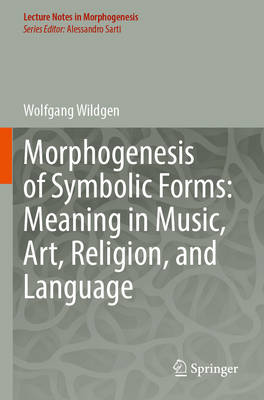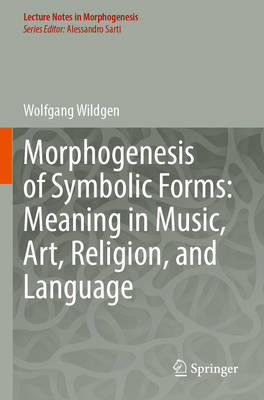
- Afhalen na 1 uur in een winkel met voorraad
- Gratis thuislevering in België vanaf € 30
- Ruim aanbod met 7 miljoen producten
- Afhalen na 1 uur in een winkel met voorraad
- Gratis thuislevering in België vanaf € 30
- Ruim aanbod met 7 miljoen producten
Zoeken
Morphogenesis of Symbolic Forms: Meaning in Music, Art, Religion, and Language
Wolfgang Wildgen
€ 147,95
+ 295 punten
Omschrijving
In the present book, the starting line is defined by a morphogenetic perspective on human communication and culture. The focus is on visual communication, music, religion (myth), and language, i.e., on the "symbolic forms" at the heart of human cultures (Ernst Cassirer). The term "morphogenesis" has more precisely the meaning given by René Thom (1923-2002) in his book "Morphogenesis and Structural Stability" (1972) and the notions of "self-organization" and cooperation of subsystems in the "Synergetics" of Hermann Haken (1927- ). The naturalization of communication and cultural phenomena is the favored strategy, but the major results of the involved disciplines (art history, music theory, religious science, and linguistics) are respected.
Visual art from the Paleolithic to modernity stands for visual communication. The present book focuses on studies of classical painting and sculpture (e.g., Leonardo da Vinci, William Turner, and Henry Moore) and modern art (e.g., Jackson Pollock and Joseph Beuys). Musical morphogenesis embraces classical music (from J. S. Bach to Arnold Schönberg) and political songwriting (Bob Dylan, Leonhard Cohen). The myths of pre-literary societies show the effects of self-organization in the re-assembly (bricolage) of traditions. Classical polytheistic and monotheistic religions demonstrate the unfolding of basic germs (religious attractors) and their reduction in periods of crisis, the self-organization of complex religious networks, and rationalized macro-structures (in theologies). Significant tendencies are analyzed in the case of Buddhism and Christianism. Eventually, a holistic view of symbolic communication and human culture emerges based on state-of-the-art in evolutionary biology, cognitive science, linguistics, and semiotics (philosophy of symbolic forms).
Visual art from the Paleolithic to modernity stands for visual communication. The present book focuses on studies of classical painting and sculpture (e.g., Leonardo da Vinci, William Turner, and Henry Moore) and modern art (e.g., Jackson Pollock and Joseph Beuys). Musical morphogenesis embraces classical music (from J. S. Bach to Arnold Schönberg) and political songwriting (Bob Dylan, Leonhard Cohen). The myths of pre-literary societies show the effects of self-organization in the re-assembly (bricolage) of traditions. Classical polytheistic and monotheistic religions demonstrate the unfolding of basic germs (religious attractors) and their reduction in periods of crisis, the self-organization of complex religious networks, and rationalized macro-structures (in theologies). Significant tendencies are analyzed in the case of Buddhism and Christianism. Eventually, a holistic view of symbolic communication and human culture emerges based on state-of-the-art in evolutionary biology, cognitive science, linguistics, and semiotics (philosophy of symbolic forms).
Specificaties
Betrokkenen
- Auteur(s):
- Uitgeverij:
Inhoud
- Aantal bladzijden:
- 208
- Taal:
- Engels
- Reeks:
Eigenschappen
- Productcode (EAN):
- 9783031256530
- Verschijningsdatum:
- 3/03/2024
- Uitvoering:
- Paperback
- Formaat:
- Trade paperback (VS)
- Afmetingen:
- 155 mm x 235 mm
- Gewicht:
- 347 g

Alleen bij Standaard Boekhandel
+ 295 punten op je klantenkaart van Standaard Boekhandel
Beoordelingen
We publiceren alleen reviews die voldoen aan de voorwaarden voor reviews. Bekijk onze voorwaarden voor reviews.











